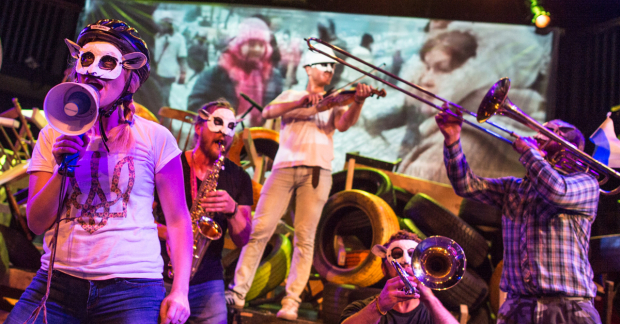Matt Trueman: Why immersive theatre rarely works
Having had enough of ‘feeling like a lemon’ when watching immersive theatre, Matt examines the much-welcomed shift to enactment

Immersive theatre makes me feel like a lemon. There’s little in life as ludicrous as interacting with an actor in character. I’ve quizzed suspects in Sherlock-style whodunits, and legged it from zombies drenched in stage blood. I’ve danced at palatial balls and been barked at by Nazis. And I almost always just feel like a dick.
Face it, it’s a bit silly, immersive theatre. We all know it’s not real and yet we pretend otherwise for the sake of the show, bowing to ‘princes’ and running after white rabbits. It’s a kids’ game in a theme park; a fancy dress do without booze to push past the shame.
Only very occasionally do I get swept up in immersive theatre. My first Punchdrunk show, a decade ago, was such an exhilarating thrill, so unlike anything else, that I chased Faust and co without a second thought for the situation. You Me Bum Bum Train, too, works best when it is so quick that you lose your bearings and act on impulse, succumbing to whatever scenario you land in.
To work, immersive theatre needs to be watertight. I’ll never forget clambering over rubble in The Masque of the Red Death to emerge in the smoking garden of Battersea Arts Centre. The moment the Bum Bum Train slows down, I spot myself pretending and self-consciousness swallows me whole. Secret Cinema’s the same. Always.
Enactment never insists you invest in a fiction, only that you play along with a play
Thank God then, that immersive theatre seems to have given way to something else. This summer, several shows have taken a different approach: not immersive, but enactment. In Edinburgh, Counting Sheep, Mish Grigor’s The Talk and Daniel Oliver’s Weird Séance all relied on it, as does Fix and Foxy’s A Doll’s House.
Rather than chuck us into the world of a play as immersive theatre does, enactment invites us to join in with the theatrical event – and it’s all the more effective for that.
Take Counting Sheep. Instead of pretending we were protestors in Maidan Square, it asked us to perform a protest in a church hall in Edinburgh. The burning barricades were represented by red streamers flying overhead. The ‘bricks’ we threw were foam. The emotions, even if only echoes of the real thing, were real. I sort of mourned for the barricades. I was flushed with adrenaline.
Enactment never asks you to pretend per se, but to perform. It never insists you invest in a fiction, only that you play along with a play. It is the acting of acting that counts and these shows never let us lose sight of the theatrical frame. As such, they’re far more robust. It’s like fourth wall naturalism and Brecht; the one snags on reality, the other admits it. You fall out of a pretence. You get wrapped up in a performance.
Where immersive theatre asks us to pretend, our instinct is to disbelieve
The act of enacting is real. In A Doll’s House, a real husband and wife essentially walk through a split. He, as Torvald, tells her he can’t love her and she, as Nora, walks out of their home. Both are real actions, albeit framed through fiction. They leave real marks and trigger real emotions. They are, in a way, possible alternatives. Counting Sheep trains its audience in protest. Mish Grigor’s The Talk gets audience members to talk about sex in public. The act of acting is the important thing.
There’s a whole theory of acting based on the same principle: outside-in. Where inside-out acting (Stanislavski and method acting etc) starts by summoning emotions and allowing them to find physical expression, outside-in acting works in reverse. By adopting the outward shape of an emotion, the emotion itself – or something like it – should follow.
Back in the day, actors were schooled in the gestures and facial expressions to play various emotional states: a kind of code for feelings. These weren’t just empty shapes, though: masks and postures. They were triggers, shortcuts to feeling. The body and the emotions aren’t as distinct as all that. Feelings – and the clue’s in the name – aren’t just mental states, but bodily ones. The connection runs both ways.
That’s why enactment is such a powerful thing. Where immersive theatre asks us to pretend, our instinct is to disbelieve. Enactment works in reverse. In asking us to disbelieve, emotional investment catches us off-guard – all without feeling like a lemon.












